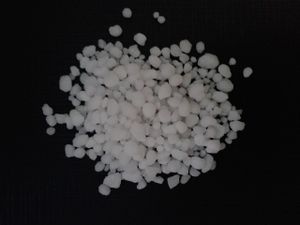Calcium nitrate
Calcium nitrate, also called Norwegian saltpeter (Norgessalpeter), is the inorganic calcium compound with the formula Ca(NO3)2.
Contents
Properties
Chemical
Calcium nitrate is a source of both calcium and nitrate ions in reactions. Because of its hygroscopicity, it is unsuitable for use as an oxidizer in energetic mixtures; however, due to the insolubility of many calcium salts, the nitrate ion in calcium nitrate can easily be used to prepare other more useful nitrates as well as other calcium compounds. Examples of this include the addition of sodium carbonate to precipitate calcium carbonate and leave sodium nitrate in solution, or the addition of potassium sulfate to generate potassium nitrate in solution, precipitating calcium sulfate. Virtually any nitrate compound can be produced by addition of a sulfate or carbonate solution in this manner.
Physical
Calcium nitrate is a white, hygroscopic solid. It presents itself as a tetrahydrate. Calcium nitrate is extremely soluble in water. The dissolution of calcium nitrate tetrahydrate in water is highly endothermic, making it useful in cooling baths. It is also soluble in alcohol and acetone, but insoluble in concen. nitric acid.
Availability
Calcium nitrate can be bought as a fertilizer, often for hydroponics. It is fairly pure, unlike ammonium nitrate which usually contains calcium sulfate to reduce its explosive hazard. However it can also be found together with ammonium nitrate, and that fertilizer is known as calcium ammonium nitrate.
Preparation
Calcium nitrate can be prepared from the reaction of calcium carbonate and nitric acid. It can also be prepared by reacting calcium hydroxide with ammonium nitrate.
Projects
- Making Copper(II) nitrate
- Make nitric acid
Handling
Safety
Because of its hygroscopicity, it cannot sustain an energetic mixture like other nitrates, such as potassium nitrate can, making it useful as a safe nitrate ion source. Skin contact with the anhydrous compound should be avoided as it can be irritating.
Storage
Calcium nitrate hydrate should be stored in closed bottles, in a place with low moisture. The anhydrous form should be stored in sealed bottles, as it is hygroscopic.
Disposal
Calcium nitrate without toxic impurities can be safely dumped in the environment, as it has low toxicity and it is a nitrogen source for plants. Avoid dumping large amounts though.
